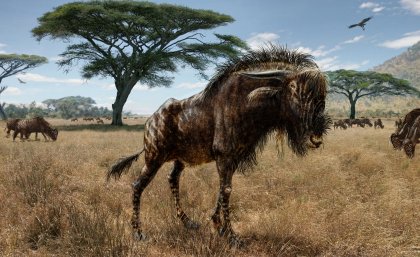
An ancient wildebeest-type animal and a member of the dinosaur family have several similarities, a team of researchers has discovered.
Working on fossilised skulls found in Kenya, the team, which included University of Queensland researchers, discovered the wildebeest’s trumpet like nasal passage was similar to the nasal crests of lambeosaurine hadrosaur dinosaurs — crested, duck-billed dinosaurs.
UQ School of Social Science researcher Dr J. Tyler Faith said findings showed a convergent evolution across millions of years between two very distantly related species.
He said his involvement in the project began in 2009, when working at the Bovid Hill site near Lake Victoria, where fossils of many Bovidae (buffalos, antelopes) had been found.
“After several years of collecting fossils from Bovid Hill, it became very clear that most of the fossils belonged to the poorly known species Rusingoryx atopocranion," Dr Faith said.
"I was astonished to see that the skulls looked unlike any antelope that I had ever seen — the only thing more surprising would have been fossil zebras with horns growing from their heads.
"The anatomy was clearly remarkable.”
During further testing the similarity to hadrosaurs was immediately clear to the researchers.
The team, including School of Earth Sciences researcher Dr Gilbert Price, hope to continue to explore the developmental shifts required to produce the animals' bizarre biological structure and to understand what ultimately led the once-thriving Rusingoryx to disappear.
One of the researchers, Dr Haley O’Brien from Ohio University USA, said both Rusingoryx and hadrosaur dinosaurs were thought to have been highly social.
“They might have communicated with each other across fairly large distances,” she said.
"Vocalisations can alert predators, and moving their calls into a new frequency could have made communication safer.
"On top of this, we know Rusingoryx and hadrosaurs were herbivores, each having their own highly specialised teeth.
“Their respective, remarkable dental specialisations may have initiated changes in the lower jaw and cheek bones that ultimately led to the type of modification we see in the derived, crest-bearing forms.”
The full report is published in Current Biology.
Link to video of skull animation - here.
Media: Dr Tyler Faith, j.faith@uq.edu.au, Kenyan mobile +254 (0)792 925 983 (until Feb 8), Australian phone 07 33653314; UQ Media, Gillian Ievers, g.ievers@uq.edu.au, 07 33461633, 0406 510 668.
.jpg)

